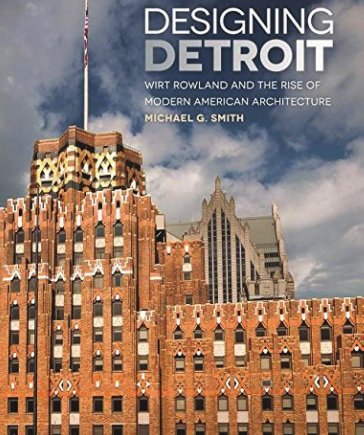
It’s likely Detroit’s architectural gems, the Guardian Building, the Penobscot, the Buhl and the General Motors Building, looming over the city like art-deco cathedrals, helped land Detroit on the top 10 cities for Lonely Planet’s “Best in Travel 2018.” Or maybe, it was the beautifully symmetrical manhole cover designed for Michigan Bell, a subsidiary of AT&T, that pushed Detroit to number two on that list.
All of these covers were designed by the little-known architect Wirt Rowland who worked in the shadows of the better-known architects Albert Kahn and George D. Mason. They may have been better known, certainly, but they were not more creative or influential to the skyline of Detroit than Rowland was.
At the height of Detroit’s building boom in the 1920s, Rowland was responsible for the design of five of Detroit’s 16 skyscrapers. Most people thought and still do today, that they were attributable to Kahn. That’s soon to change, in part, due to a new book by Michael Smith, published by Wayne State University Press.
Smith has written a 500-page book, “Designing Detroit: Wirt Rowland and the Rise of Modern American Architecture.” The book is as formidable as Rowland’s architectural work, and one that examines in detail, the life and prodigious career of Detroit’s premier, but virtually unknown, architect.
Smith, like Rowland, had little training in architectural design. In his previous careers, he was a graphic artist and then a recruiter for the printing industry. Smith said it was serendipitous that he began the six-year project to research and write the book.
“In 2011, I was asked to do an architectural tour of the city for a conference.
It was then that I first discovered that all the buildings I liked were designed by the same architect: Wirt Rowland,” Smith said.
“I’m not sure why he has been overlooked,” he said. But Smith was willing to offer an answer: “The other architects were self-marketers.”
Also, perhaps contributing to the lost architect mystique was the fact that Rowland’s work was unlike any other design going on at the time. The magnificent Guardian Building, home of Union Savings bank, was not overwhelmingly well-received at the time, but today it is considered “America’s premier Art Deco bank building” according to the book “American Art Deco.”
Many of the buildings and work of Rowland that Smith details in the book are still as beautiful as the day they were completed. Others, like the Detroit News building, Detroit Free Press Building and the Rayl Hardware Company building — now the upcoming Shinola Hotel — have been beautifully restored and repurposed. Other notable works are the Ambassador Bridge and the Selfridge Air National Guard Base.
Although Rowland’s work was primarily in and around Detroit, his designs were also used in buildings in Grand Rapids, Flint, Saginaw and Ann Arbor. In Ann Arbor, the Arthur Hill Auditorium and the Hatcher Library are examples of buildings still in use today.
Smith said that Rowland’s work outside Detroit were unique, as from 1900 to 1930 architects in Detroit did not generally have to leave the city for work.
“There was so much building going on in Detroit that the numbers were staggering,” he said.
Smith tells how Rowland’s used his musical skills — he was an accomplished vocalist — to design the unique acoustics in Hill Auditorium. Contributing to Rowland’s innovative work also, was the recent advancement of reinforced concrete which enabled the construction of taller buildings with elegant designs.
One of the great contributions of Smith’s work too, is that it tells the back story of the economic rise of Detroit. It’s likely if a community has a Bell Telephone structure within its city limits it was designed by Rowland.
Although his work is not designed as a textbook, “Designing Detroit” is an easily approachable introduction to architectural design. Smith has included geometric sketches, and a crib section that opens the book detailing architectural terms and designs.
Smith’s book is particularly refreshing in light of the numerous architectural porn books which were published in the last five years on Detroit’s crumbling infrastructure.
“If I could be buried anywhere, the Guardian (building) would be the place,” Smith said.
Support City Pulse - Donate Today!
Comments
No comments on this item Please log in to comment by clicking here